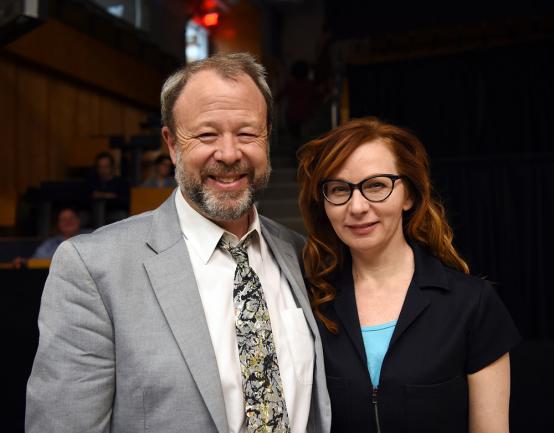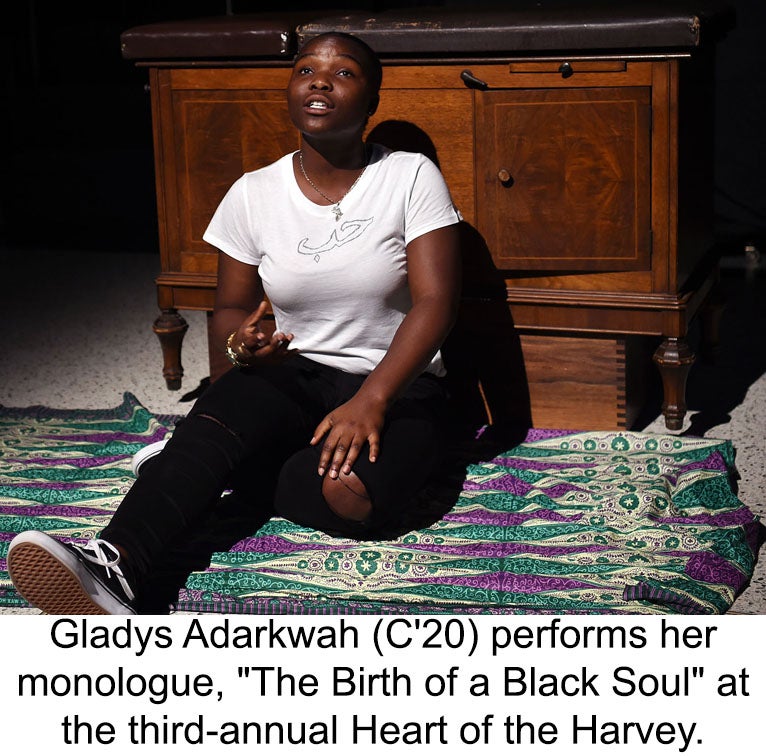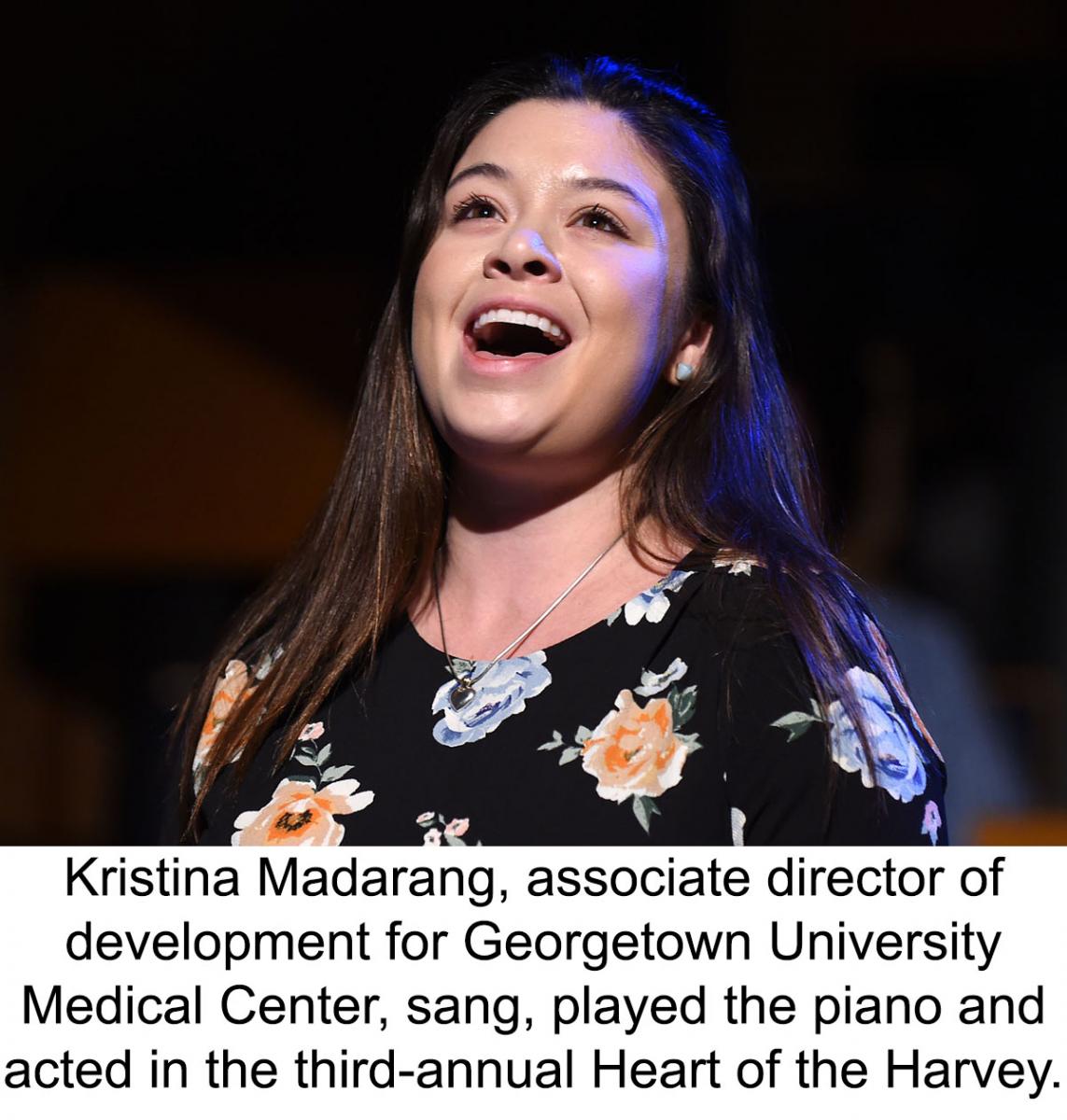Making Space for the Soul at the Heart of the Harvey

Posted in GUMC Stories
(April 16, 2018) — When Susan Lynskey, MFA, first saw the restored W. Proctor Harvey Clinical Teaching Amphitheater in the Medical-Dental Building, she told Stephen Ray Mitchell, MD, MBA, dean of medical education at the School of Medicine, that it looked “like a Victorian operating theatre redesigned for the 21st century.”
“He laughed and said, ‘Why yes,’ and adjusted his bow tie,” said Lynskey, associate professor of the practice in theatre and performing arts at Georgetown. “And I said, ‘Ray, Dr. Rebeck and I would like to transform this from a Victorian operating theatre into an operating theatre.’ And all the heart lights went on at once.”
Lynskey shared her reflections on that fateful conversation at the third-annual Heart of the Harvey on April 13 in Proctor Harvey Amphitheater. The night of plays, poetry, music and monologues celebrated the writing and performances of students, faculty, staff and alumni from across the university.
The Heart of the Harvey was presented by the Operating Theatre, led by co-founding artistic directors Lynskey and Bill Rebeck, PhD, MFA, professor of neuroscience. In addition to their roles in the Operating Theatre, Lynskey performed in “Placebo Control,” a play written by Rebeck about a pair of congenic mice contemplating their role in research.
“It was inspired by a desire to bring scientific principles to the larger public in enjoyable ways,” Rebeck said. “But it was probably more inspired by the simple existential question of why we are all here.”
Lynskey was thrilled to help bring Rebeck’s play to life, in part because it their involvement in the show’s content reminded “all involved that this creative investigation into the human condition is intersectional and lifelong,” she said. “It says to students that we too, as their teachers and mentors, are willing to try, risk, make ourselves vulnerable and courageous, just as we ask them to do.”
A Fitting Venue
Proctor Harvey, the amphitheater’s namesake, was known as the country’s leading expert in the field of auscultation, “the detection of cardiac ailments made by closely listening to the heart,” said Nellie Darling (NHS’11, M’21), president of the School of Medicine’s Arts & Medicine club. The amphitheater continues to host a class in heart sounds that Harvey taught during his 55-year career on the faculty at the School of Medicine.
The heart sounds workshop showed Darling “that there’s a lot more music in cardiology than you ever realized before,” said Darling, who also acted in the show. “This was my first exposure to the art of medicine in a medical course and so I think it’s very fitting that you’ll see the heart and soul of medicine in the same exact space as countless have before.”
Making the most of the space in the amphitheater was one of Kate Colwell’s goals when she sat down to write after seeing the second-annual Heart of the Harvey. In the debut of her play “L-I-M-B-O,” angels gave audience members bingo cards and ran up and down the stairs of the amphitheater, hosting a game show set in the afterlife.
“There’s something special about having a theater event in a medical classroom,” said Colwell, communications staff writer/editor in the Office of Advancement. “Think about how many students have sat up in these stands watching the human body being opened up so they can see how it works. We’re trying through this event to examine the human spirit instead of the human body.”
Focused on the Soul

While the themes for previous events have included the mind and the heart, the soul was the theme for this year’s Heart of the Harvey. “Being a part of the show thus far has been a good experience because I really like the theme,” said Gladys Adarkwah (C’20), who wrote and performed her monologue “The Birth of a Black Soul.”
As a student in Lynskey’s acting class, Adarkwah was encouraged to participate in the event. “My monologue was inspired by the story of how my mother gave birth to me, which I have been told multiple times by my sister but no matter how many times I hear it, it never ceases to amaze me the resilience and strength my mother has,” she said.
Adarkwah’s monologue also addressed the culture shock she experienced moving from Ghana to New Jersey as a child, as well as her struggle to embrace her African identity and fit in to Black American culture in spite of the violence, discrimination and inequality Black Americans face. “I am excited to present my piece, and my hope is that it speaks for the voices that go unheard every day while raising awareness of the injustices in this world,” she said.
Creating a Space for Artistic Expression

Participating in a program that gives medical students an opportunity to show their artistic sides was appealing to Colwell. “This is a wonderful venue for people to express themselves in a way that maybe they’ve been missing. I think that’s really beautiful, presenting artists an opportunity that values their talents and their time. Through the Heart of the Harvey, they can develop into multifaceted people, no matter what is going on in their lives,” she said.
In her experiences as a vocalist, Kristina Madarang, associate director of development for Georgetown University Medical Center, has found that performing can be therapeutic, and she hoped that the medical students and faculty members participating felt that way as well. “They don’t typically have a sanctioned outlet to deal with a lot of the things they see,” she said.
Ultimately, the Heart of the Harvey shows medical students that “they can be artists and doctors and they don’t have to choose,” Colwell said.
Before the third-annual event had even taken place, Madarang was already looking ahead. “Definitely Heart of the Harvey will be a thing for me,” she said. “Participating in the Heart of the Harvey has been a refreshing and thoroughly enjoyable process that I encourage others to experience.”
Kat Zambon
GUMC Communications
